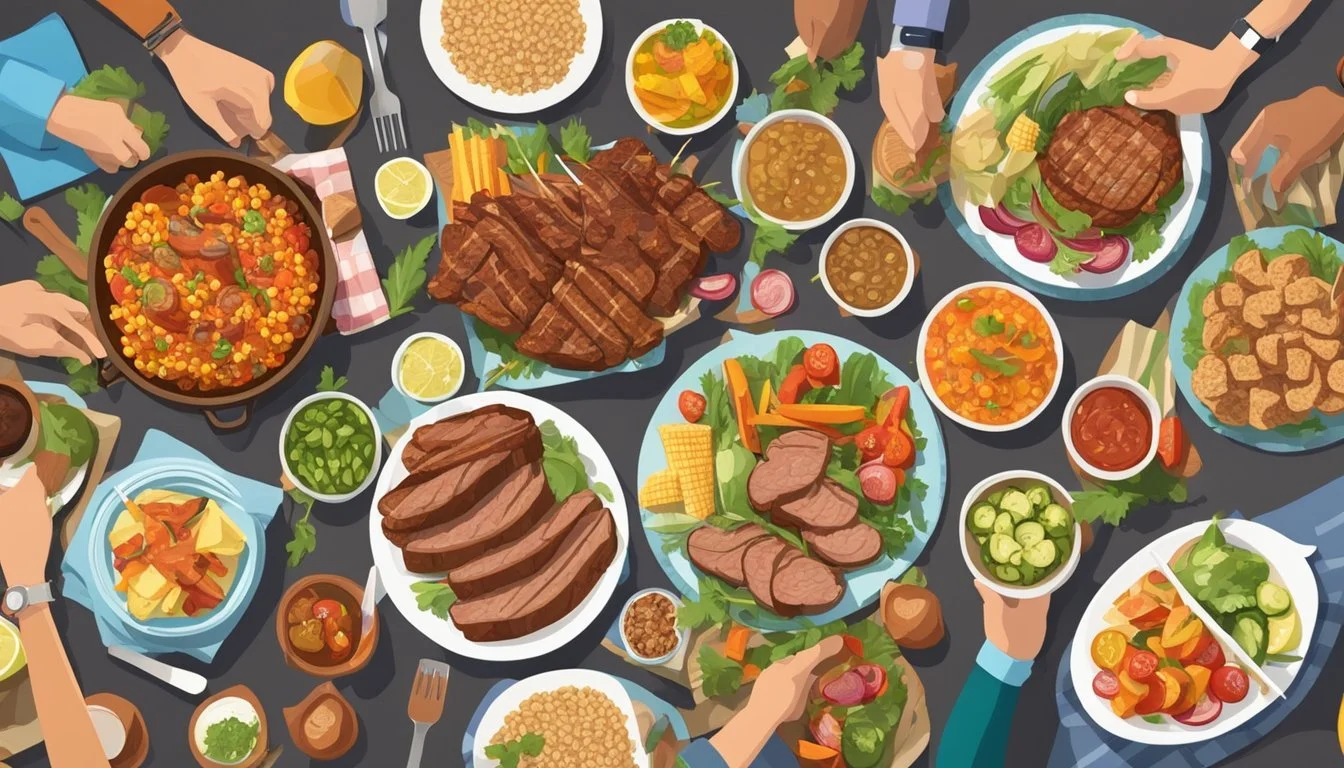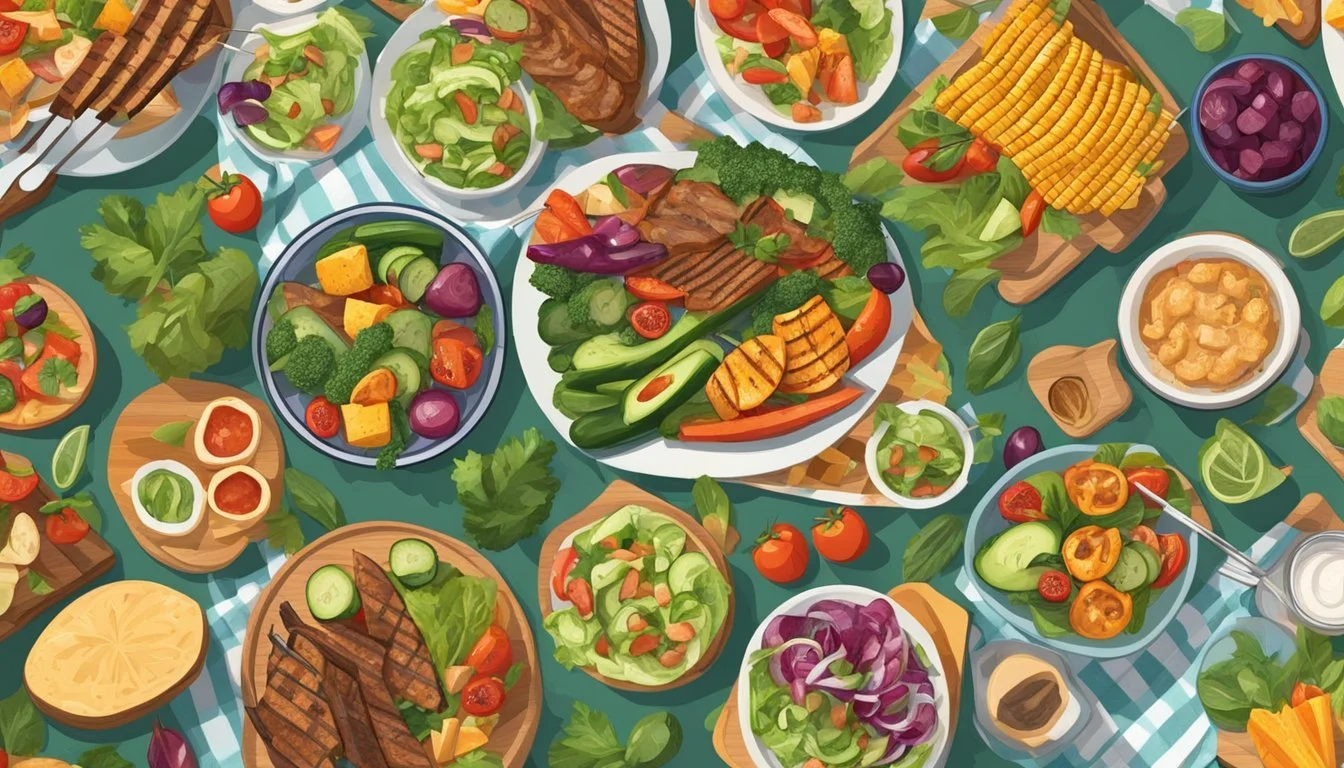How to Host a Grain-Free Barbecue or Picnic
Your Guide to a Delicious, Wheat-Free Menu
Hosting a grain-free barbecue (What wine goes well with barbecue?) or picnic can be a delightful way to enjoy the company of friends and family while still catering to dietary restrictions or preferences. With an increasing number of individuals opting for grain-free lifestyles due to health reasons or personal choice, the demand for inclusive outdoor dining experiences is on the rise. A well-planned event that considers these needs ensures that all guests can relish the flavors and joy of outdoor eating without grains.
To successfully host a grain-free gathering, it's important to focus on a wide array of proteins, vegetables, and fruit that naturally contain no grains. Traditional barbecue fare, such as grilled meats (What wine goes well with grilled meats?) and fish, can easily be adapted to be grain-free by choosing rubs and marinades devoid of grain-based ingredients. For variety, vegetable kebabs and salads made from fresh produce can complement the main dishes, providing a colorful and nutritious spread that pleases the palate.
Conveniently, picnics offer a plethora of grain-free options ranging from lettuce wraps to stuffed avocados. They are a testament to the flexibility in menu planning for a grain-free diet. Picnic staples such as hard cheeses, nuts, and olives can serve as appetizers or snacks. By thoughtfully selecting ingredients and recipes, hosts can create a memorable outdoor dining experience that is both grain-free and satisfying, ensuring everyone leaves with full stomachs and happy memories.
Hosting a grain-free barbecue or picnic can be a delightful and health-conscious endeavor, with a plethora of options to explore. The grain-free nutritional impact of such gatherings can be truly beneficial, offering wholesome and nutritious alternatives to traditional grain-heavy meals. For those aiming to overcome grain-free weight loss plateaus, a grain-free barbecue or picnic can provide a refreshing change of pace and a variety of delicious, satisfying options.
When planning your menu, consider incorporating grain-free tortillas for delectable tacos and wraps, providing a flavorful and wholesome twist to classic favorites. Elevate your dishes with grain-free condiments and dressings, adding a burst of flavor without compromising your dietary choices. Whether you're enjoying your picnic at a local park or while grain-free traveling, these choices can elevate the experience.
Furthermore, embracing carbohydrates grain-free options can positively impact skin and hair health, making your gathering not only a culinary delight but also a boon for overall well-being. With a focus on delicious, nutritious food and mindful choices, hosting a grain-free barbecue or picnic can be a joyful celebration of health and flavor.
Planning Your Grain-Free Barbecue or Picnic
When the grilling season beckons, a grain-free barbecue or picnic can be both a delightful challenge and a healthy alternative. One's plan should start with selecting the ideal outdoor venue—be it a park, a beach, or even one's own backyard. The key is to ensure ample space for guests and activities.
Venue Selection:
Park: Ample space, often with grills and tables
Beach: Scenic and casual, but ensure grilling is permitted
Backyard: Private and easily accessible
With the location set, guests can be encouraged to bring their own blankets for a picnic-style gathering, promoting a casual and relaxed atmosphere.
Menu Planning: A grain-free menu requires thoughtful consideration to accommodate dietary restrictions while ensuring a variety of flavors. Protein sources like meats and fish are the centerpieces of a barbecue and can be paired with an array of vegetable sides. For a creative touch, one might include skewers of marinated chicken, beef, or seafood, and a rainbow of grill-friendly vegetables such as bell peppers, zucchini, and asparagus.
Suggested Protein Options:
Chicken
Beef
Fish
Seafood
Grill-Friendly Vegetables:
Bell peppers
Zucchini
Asparagus
Mushrooms
Preparation begins with ensuring all ingredients are grain-free, including sauces and marinades. One must also provide a selection of grain-free beverages, such as infused waters, iced herbal teas, or even a summer sangria made with fresh fruit and grain-free spirits.
In summary, the success of a grain-free barbecue or picnic hinges on careful planning, a diverse grain-free menu, and a selection of refreshing beverages, ensuring a memorable outdoor gathering for all.
Selecting the Right Foods
When hosting a grain-free barbecue or picnic, it's crucial to craft a menu that satisfies dietary restrictions while providing a variety of delicious options that everyone can enjoy. Thoughtful selection of main dishes, sides, salads, desserts, and appetizers will ensure a memorable experience for family and friends.
Main Dishes
Grain-free main dishes can be both creative and mouthwatering. Hosts can grill a flat iron steak to perfection for a robust, flavorful entrée. For those avoiding meat, grilled jackfruit can be seasoned to mimic pulled pork. Easy-to-prepare burgers made from either grass-fed beef or a vegan alternative can cater to all guests, with lettuce wraps available as a grain-free bun option. Simple marinated chicken thighs (What wine goes well with chicken thighs?) or breast also make for a succulent and gluten-free centerpiece of the meal.
Sides and Salads
Sides should complement the main dishes without the grains. A crisp broccoli salad, dressed in a homemade vinaigrette, offers a fresh, vibrant choice. Traditional coleslaw and potato salad can be adapted to be gluten-free by ensuring the use of a safe mayonnaise or dressing. It’s also easy to put together a variety of other colorful and refreshing salads using a mix of fresh vegetables, herbs, and grain-free dressings.
Desserts
No meal is complete without something sweet, and grain-free options abound. Chocolate lovers can indulge in gluten-free vegan brownies or a rich, flourless chocolate cake. Lighter options might include fruit salads or refreshing scoops of dairy-free ice cream. For individual treats, vegan vanilla cupcakes made with almond or coconut flour are a perfect single-serving option.
Appetizers and Snacks
Kick off the event with appetizers that entice but don't overwhelm. Consider a platter of fresh veggie sticks served with a tangy salsa verde or a rich, creamy dip. Chips made from alternative ingredients like sweet potatoes or kale can be offered instead of traditional grain-based ones, providing a satisfying crunch without the grains. These starters set the stage for the feast to follow without stealing the spotlight.
Special Diet Considerations
When hosting a grain-free barbecue or picnic, it is important to account for various dietary preferences and restrictions. Offering a range of options ensures that all guests can enjoy the meal without compromising their diet or wellness goals.
Gluten-Free Alternatives
For those with gluten sensitivities, traditional barbecue fare can be tricky. Gluten is often found in items like buns and certain sauces. Opting for gluten-free buns or using lettuce wraps can be an excellent alternative for burgers and hot dogs. When choosing a bbq sauce, one should ensure that it's labeled gluten-free, as many sauces contain gluten as a thickening agent.
Vegan and Vegetarian Options
Vegan and vegetarian guests may appreciate plant-based proteins such as veggie burgers or grilled tofu (What wine goes well with grilled tofu?) . A homemade vegan pesto with basil is a versatile condiment that can add flavor to grilled vegetables (What wine goes well with grilled vegetables?) or as a dressing for salads. Additionally, vegan brownies made without dairy or eggs can be a delightful, inclusive dessert choice.
Low-Carb and Paleo Foods
The low-carb and paleo diets often overlap with grain-free preferences. For these guests, one might offer a selection of meats and seafood that are grilled without sugary sauces. Vegetables, either raw or grilled, can serve as a nutritious and satisfying side. Salads with leafy greens, topped with high-fat dressings or avocado, also cater to those following low-carb diets.
Grilling Techniques and Safety
When hosting a grain-free barbecue, the grill master must prioritize safety while ensuring dishes retain real, authentic flavors. Grilling methods should be adapted to incorporate grain-free options, focusing on whole foods such as meats, fish, and vegetables.
Preparation:
Thorough cleaning of the grill before use to prevent cross-contamination.
Pre-heating the grill to the right temperature; for charcoal grills, allow coals to reach a white ash appearance.
Cooking Temperatures:
Proper meat temperatures ensure safety without compromising on taste and quality.
Food Item Internal Temperature Beef, Pork, Lamb, Veal (whole cuts) 145°F followed by a 3-minute rest Fish 145°F or until opaque and separates easily Ground Beef (hamburgers) 160°F Poultry and Pre-cooked Meats (e.g., hot dogs) 165°F
Safety Tips:
Keep a fire extinguisher nearby and know how to use it.
Position the grill away from structures, overhanging branches, or any flammable materials.
Use long-handed utensils to avoid burns and splatters.
Never leave the grill unattended.
The host should also consider dietary restrictions by offering a variety of grain-free dishes. They can interact with guests to ensure their dining preferences are respected while maintaining a focus on the grilling process. It is essential for the host to embody both the roles of a vigilant cook and an attentive host, creating a safe and enjoyable experience for everyone.
Creating a Comfortable Setting
When hosting a grain-free barbecue or picnic, the comfort of the guests is paramount. Creating a comfortable setting involves selecting an ideal location, arranging seating and decor thoughtfully, and ensuring food safety and preservation.
Choosing a Location
A successful host considers the location carefully, ensuring it is accessible and comfortable for all guests. A park or beach can offer a scenic backdrop and ample space for gatherings, but one must check for amenities such as shade, restrooms, and grill areas. Select a spot where there's enough room for guests to move around and interact, keeping in mind the ease of sharing meals and conversation.
Seating and Decor
Seating should be ample and arranged to promote a convivial atmosphere. Utilize a combination of picnic tables, outdoor chairs, or blankets to provide a variety of seating options. For a touch of elegance, add simple decor like tablecloths or centerpieces. Here's a layout suggestion for seating:
Picnic Tables: Central area for dining
Chairs: Scattered in conversation-friendly clusters
Blankets: Spread out on the ground for relaxed, casual seating
Tip: Always have extra seating available to accommodate unexpected guests or to offer comfort as the event progresses.
Food Safety and Preservation
Grain-free dishes often require careful handling to prevent spoilage, especially when outdoors. Food should be maintained at safe temperatures, with cold dishes kept in coolers and hot dishes served fresh off the grill. Use insulated containers and ice packs for cold storage, and food covers to protect dishes from outdoor elements.
Cold Dishes: Store below 40°F in coolers
Hot Dishes: Keep above 140°F until serving
Room Temperature: Use for stable items only and minimize exposure time
By thoughtfully choosing a location, arranging comfortable seating and decor, and effectively managing food safety and preservation, a host can ensure a pleasant and memorable grain-free barbecue or picnic experience.
Delicious Grain-Free Recipes
Grain-free barbecues and picnics can be just as sumptuous and satisfying as traditional menus. The following recipes provide a variety of flavorful options that satisfy dietary preferences without sacrificing taste or enjoyment.
BBQ and Grilling Recipes
Grain-free BBQ enthusiasts can find delight in almond flour blueberry bread, perfect for an afternoon snack. When grilling, opting for grilled vegetables like cauliflower, zucchini, and bell peppers offers a healthy and colorful addition to any BBQ spread. Using homemade bbq sauce free from added sugars and grains can enhance the taste of grilled meats while keeping the meal aligned with grain-free guidelines.
Salads and Slaws
Salads and slaws are refreshing sides for any outdoor meal. A vibrant broccoli salad, sans grains, adds crunch and nutrition. Potato salad, reinvented with sweet potatoes and olive oil-based dressings, offers a hearty and familiar favorite. For a lighter side, coleslaw made with a vinegar-based dressing provides a tangy complement to savory dishes.
Refreshing Drinks and Beverages
Hydration is key at any outdoor event, and serving lemonade sweetened with natural sweeteners like stevia maintains the spirit of grain-free dining. For those seeking more variety, homemade iced teas or infused waters with cucumber, lemon, or berries are not only refreshing but also visually appealing options.
No-Bake Desserts
The best way to round off a grain-free picnic or BBQ is with a tempting dessert. Opt for no-bake desserts such as chocolate-dipped fruit or mixed berry compote served with dairy-free ice cream. These desserts offer the sweetness and indulgence expected at a picnic without the need for grains or extensive preparation.
Hosting Tips and Etiquette
When hosting a grain-free barbecue or picnic, the host should remain mindful of guests' dietary needs, ensuring a welcoming environment for family and friends alike. They must communicate clearly about the grain-free theme, so guests know what to expect and share accordingly if it's a potluck event.
Preparation:
Begin with thorough planning, ascertaining ample grain-free options are available.
Skewer vegetables and meat alternatives, keeping them chilled before grilling.
During the Event:
The host should interact with guests, joining in the festivities rather than just managing the grill.
Hygiene is paramount, especially when handling various food items to prevent cross-contamination.
Food Safety Cleanliness Sharing Ensure all food, particularly proteins, are cooked to the appropriate temperatures. Maintain clean utensils and serving areas. Encourage guests to share their dishes, describing the ingredients used.
Seating Arrangements:
Offer plenty of space at tables, aiming for comfort rather than squeezing in extra seats.
Communication:
Prepare and send invitations with clear information, including the fact that the event is grain-free.
The host should also be prepared with knowledge of grain-free alternatives for traditional barbecue fare, enabling them to cater to all guests with confidence and ease. Offering a variety of foods and clearly labeling them allows guests to navigate their choices effortlessly, contributing to an enjoyable grain-free experience.
Cleanup and Waste Reduction
When hosting a grain-free barbecue or picnic, responsible cleanup and waste reduction are key to an environmentally friendly gathering. Attendees can contribute to a cleaner environment by following these simple guidelines.
During the Event:
Provide clearly labeled bins for recycling, composting, and trash. They should encourage sharing responsibility among guests for proper waste disposal.
Opt for reusable plates, utensils, and napkins instead of single-use items. If disposables are necessary, choose biodegradable or compostable options.
Post-Event Cleanup:
Assign a team to oversee the cleanup process to ensure that nothing is overlooked.
Use eco-friendly cleaning products to ensure safety for both the attendees and the environment.
Waste Reduction Tips:
Reuse where possible; encourage guests to bring containers for leftovers, supporting both waste reduction and food sharing.
Compost any food scraps and biodegradable items.
Recycle all eligible materials like glass, metals, and certain plastics.
Safety Measures:
Avoid burning or burying waste, which could be harmful to both the environment and guest safety.
Store waste in animal-proof containers if the event extends overnight.
By considering these practices, hosts can significantly reduce the environmental impact of their event without compromising on the enjoyment or safety of their guests. The success of a grain-free barbecue or picnic rests not just on the food and fellowship but also on the commitment to leave no trace behind.
Conclusion
Hosting a grain-free barbecue or picnic is all about ensuring that everyone has a delightful experience while sticking to dietary preferences or requirements. One finalizes their event by considering a selection of grain-free dishes, employing careful planning, and focusing on fresh, whole food ingredients. Such gatherings are an opportunity to share delectable food that satisfies all guests, including those who follow grain-free diets.
To recap, consider the following points to ensure the barbecue or picnic is enjoyable and inclusive:
Menu Planning: Select a variety of grain-free meats, vegetables, and fruits to create a colorful and appetizing spread.
Cooking Techniques: Utilize grilling, which naturally lends itself to grain-free options.
Desserts and Beverages: Offer fruit-based desserts (What wine goes well with fruit-based desserts?) and naturally flavored water, avoiding grain-based treats and mixers.
A grain-free gathering doesn't mean a compromise on taste or enjoyment. It is a chance to explore a range of flavors and share a meal that is both health-conscious and convivial.unities to share culinary discoveries and create enjoyable moments around food that cater to diverse dietary needs without sacrificing flavor or satisfaction.








